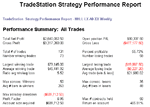Stops will hurt you if they to close. The closer you stop, the more you will get stopped out. You stops should be beyond or past random fluctuation.
They must be far enough away that if they are hit, it will be because of real -not -random activity in the market..
Also You will not find this in any books. If you got a mechanical trading system, stops can ruin the performance. if holding 1 to 2 days, just place 200 point stop, in case of something like 9/11 happening if trading the Dow.
Im not the only one with this view mark,d, cook (Market wizards) who trades the s&p uses 6 points stop for a 3 points profit.on high probability trades.
Is this why, 90% of you lose.You stops may be to near, you entry price.?
CJ.
They must be far enough away that if they are hit, it will be because of real -not -random activity in the market..
Also You will not find this in any books. If you got a mechanical trading system, stops can ruin the performance. if holding 1 to 2 days, just place 200 point stop, in case of something like 9/11 happening if trading the Dow.
Im not the only one with this view mark,d, cook (Market wizards) who trades the s&p uses 6 points stop for a 3 points profit.on high probability trades.
Is this why, 90% of you lose.You stops may be to near, you entry price.?
CJ.

